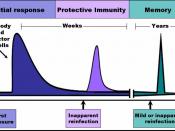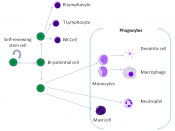Mononucleosis
The disease causing virus in infectious mononucleosis, (commonly known as mono), is the Epstein-Barr Virus, (EBV).
The primary barrier for EBV is that the virus is usually only transmitted by infected saliva, so air borne or blood infection is rare. Most people have been exposed to EBV from an early age and most people are immune by the age of 35 years old. The most common age to show symptoms of mono is during adolescence of young adulthood. The most important barrier is the bodies' immune system and defence mechanisms.
Mononucleosis is most commonly spread by contact with virus-infected saliva through coughing, sneezing, kissing, sharing drinking glasses, toothbrushes or eating utensils.
Symptom | Description |
Swollen tonsils and/or sore throat | Red, inflamed appearance in throat/mouth area. |
Fever and chills | Fatigue, listlessness, pale and feverish looking. |
Nausea and vomiting, or decreased appetite | |
Swollen lymph nodes in the neck and armpits | Swelling around armpit area. |
The 2 main defences the body uses to fight mono and many other infections, are the immune and lymphatic systems.
The Immune System
The immune system is the bodies' way of fighting off infection or anything unfamiliar to the body. When the bodies' immune system is triggered these infections are considered antigens. Firstly the white blood cells, known as leukocytes, circulating in the blood go directly to the infection, There are several types of white blood cells, the first being the large white blood cells called phagocytes, that literally eat the microbes by surrounding or engulfing them. The phagocytes then digest the 'invader' by using complex protein enzymes that break down the antigen into small, harmless pieces. They next seek out other infections for their next "meal' with the help of another type of white blood cell, the lymphocyte. There are two types of lymphocytes,


